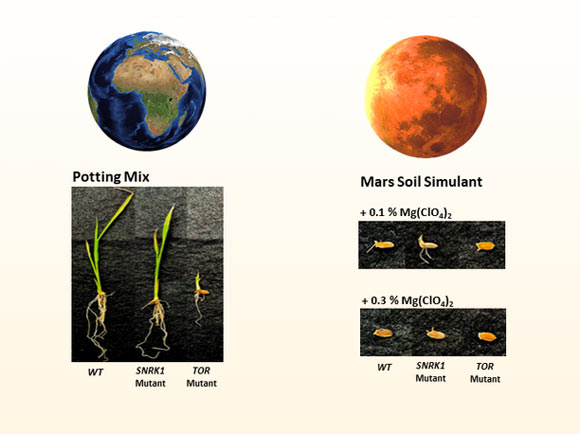One of the biggest challenges to growing food on Mars is the presence of perchlorate salts, which have been detected in the Martian regolith (soil) and are generally considered to be toxic for plants.
Gann et al. show that in principle it is possible to grow rice plants in MMS1 but levels of (Mg(ClO4)2) can be critical to both germination and growth; moreover, they presented that editing SnRK1a could potentially provide an approach to develop as table rice line that can germinate and grow in MMS1 with (Mg(ClO4)2). Image credit: Gann et al.
“In-Situ Resource Utilization will become increasingly important as human space exploration progresses,” said Peter James Icalia Gann from the University of Arkansas and his colleagues.
“Resupply missions can be expensive, so we need practical and affordable ways to use resources on other planetary bodies.”
“On Mars, there are resources such as water, regolith, light, carbon dioxide which can be used to introduce new biomass for food production.”
Gann and co-authors were able to simulate Martian soil using basaltic rich soil mined from the Mojave Desert, called the Mojave Mars Simulant 1 (MMS1), which was developed by scientists from NASA.
They then grew three varieties of rice, including one wild-type and two gene-edited lines with genetic mutations that better enable them to respond to stress, such as drought, sugar starvation or salinity.
These varieties were grown in MMS1, as well as a regular potted mix and a hybrid of the two.
While plants were able to grow in the Martian simulant, they were not as developed as those grown in the potting soil and hybrid mix.
Replacing just a quarter of the Martian simulant with potting soil resulted in improved development.
The researchers also experimented with the amount of perchlorate in the soil, finding that 3 grams per kilogram was the threshold beyond which nothing would grow, while mutant strains could still root in 1 gram per kilogram.
Their findings suggest that there might be a way forward for genetically modified rice to find purchase in Martian soil.
The team’s next steps will include experimenting with a newer Martian soil simulant called the Mars Global Simulant, as well as other rice strains that have increased tolerance for higher salt concentrations.
An important part of the research will be determining to what degree perchlorate may be leeching into the plant from the soil.
Farther down the road, the scientists would like to introduce rice into a closed habitat chamber and place it in a Mars simulation chamber that replicates the temperature and atmosphere of the planet.
“Whether humans ever colonize Mars, our research could have applications here on Earth,” said Dr. Abhilash Ramachandran, a researcher at the Arkansas Center for Space and Planetary Sciences.
“I spoke with an Australian researcher from an area where the soil had high salinity, and saw their work as a potential way to grow food there.”
“We could use Earth as a terrestrial analog before the seeds ever get sent to Mars.”
The authors presented their results in March 2023 at the 54th Lunar and Planetary Science Conference.
_____
Peter James Icalia Gann et al. Rice can grow and survive in the Martian regolith with challenges that could be overcomed through control of stress-related genes. 54th Lunar and Planetary Science Conference 2023, article # 2990




